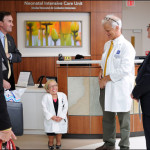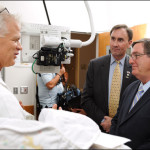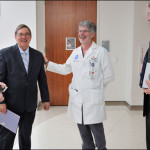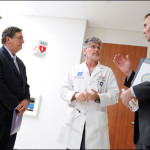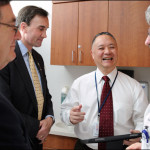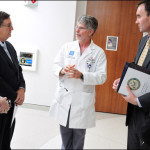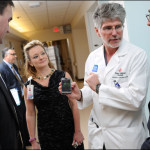September 3, 2014

On April 11, identical conjoined twin girls were born at Texas Children’s Pavilion for Women, each weighing about 3 pounds, 7 ounces. Born via Caesarean-section at 31 weeks gestation, Knatalye Hope and Adeline Faith share a liver, diaphragm, pericardial sac (the lining of the heart) and intestines. They were welcomed by their parents, Elysse and John Mata and their older brother Azariah.
Now estimated to weigh 10 pounds, 4 ounces each, the girls are being cared for by a team of specialists at Texas Children’s Newborn Center.
“The twins still require some respiratory support but they are doing well, and we don’t expect them to have any significant setbacks,” said Chief of Neonatology Dr. Stephen Welty.
Plans for surgical separation are being discussed among a team of multidisciplinary specialists. The Mata family and the care team’s goal right now is for the babies to continue to grow and gain weight.
“I expect it to go well,” Welty said in an interview with KHOU on Tuesday. “Will it be easy? No. The best thing to do is to do the safest thing, which is grow them up, get them bigger and healthier with great nutrition and great developmental care and then separate them at a time which is as safe as possible.”
Waiting a few months after the babies’ birth before proceeding with separation helps optimize the lung and organ function, which can minimize the risk of complications.
“Although other facilities have reported early separations, each case is different with regard to the number of organs that needs to be separated,” said Dr. Darrell Cass, co-director of Texas Children’s Fetal Center. “Also, in some instances those cases have experienced complications due to the early separation, which I believe can be avoided.”
Doctors anticipate beginning the twins’ separation process between the ages of 6 months and 8 months. First, our plastic surgery team will place tissue expanders to help induce the growth of additional skin that will be needed once the two babies are separated. The process of tissue expansion is six to eight weeks. Afterward, a multidisciplinary team of specialists will proceed with separation of the twins. The separation will involve many surgeons, including those from Pediatric General Surgery, Urology, Plastic Surgery, Orthopedic Surgery, Cardiac Surgery and Gynecology.
“There will be two surgical teams,” Cass said. “One team will start, and then once the babies are separated, the teams will separate to work on each infant and finish the reconstruction.”
The surgical teams include:
- Anesthesiology: Dr. Helena Karlberg and Dr. Steve Stayer
- Pediatric General Surgery: Dr. Darrell Cass (team lead) and Dr. Oluyinka Olutoye
- Pediatric Urology: Dr. Patricio Gargollo and Dr. Chester Koh
- Pediatric Plastic Surgery: Dr. Ed Buchanan and Dr. Larry Hollier
- Pediatric Orthopedic Surgery: Dr. David Antekeir and Dr. Frank Gerow
- Pediatric Gynecology surgery: Dr. Jennifer Dietrich
Cass said the surgery is risky, as there always is the risk of death for one or both children. However, he believes the risk is small and the team is anticipating an excellent outcome.









